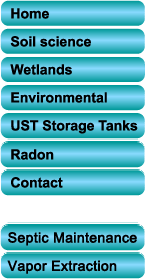GeoEnvironmental Services, Inc.
Professional Geologists & Soil Scientists Providing Environmental Consulting Services



How can I tell the difference between a conventional onsite sewage system and an alternative onsite sewage system (AOSS)? A conventional onsite sewage system is defined as “a treatment works system consisting of one or more septic tanks with gravity, pumped, or siphoned conveyance to a gravity sub surfaced drainfield”. A typical conventional onsite sewage system consists of a sewer line, two septic tanks, a conveyance line, a distribution box, header lines, and multiple absorption trenches. In most cases these components are not visible from the surface. (If the system requires a pump you will notice a riser roughly 12 inches above the ground surface.)
An alternative onsite sewage system is defined as “a treatment works system that is not a
conventional onsite sewage system and does not result in a point source discharge. A
point source discharge or direct discharge system requires a Health Department Permit
and a Department of Environmental Quality (DEQ) Permit”. A typical alternative onsite
sewage system consists of a sewer line, septic tank,
treatment unit, pump chamber, conveyance line, distribution system, and absorption field
(trenches, pad, drip tubing, etc.). With alternative systems there are typically multiple
components visible from the ground surface, most notably the access to the treatment unit.
I have an AOSS, so how do these new regulations affect me?
Section 12VAC5-613-120 of the Emergency Regulations clearly states the owner
responsibilities as it relates to the operation and maintenance of an AOSS. The
responsibilities are as follows:
As the owner of an AOSS, your responsibilities include:
- Have the AOSS operated and maintained by an operator
- Have an operator visit the AOSS at the frequency required
- Have an operator collect any samples required
- Keep a copy of the log provided by the operator
Responsibilities of the maintenance provider include:
- Inspect all components of the AOSS and conduct field measurements, sampling, and other observation required
- Perform routine maintenance, make adjustments, and replace worn or dysfunctional components
- Report immediately to the owner the remediation efforts necessary to return the AOSS to normal function
- Provide a report to the Virginia Department of Health of all required visits
What do I need to do next? Complete this form or call us at (804)730-8220 and one of our certified engineers will contact you to help you meet these requirements.
FREQUENTLY ASKED QUESTIONS - ALTERNATIVE ONSITE SEWAGE SYSTEMS (AOSS) (12VAC5-613)








